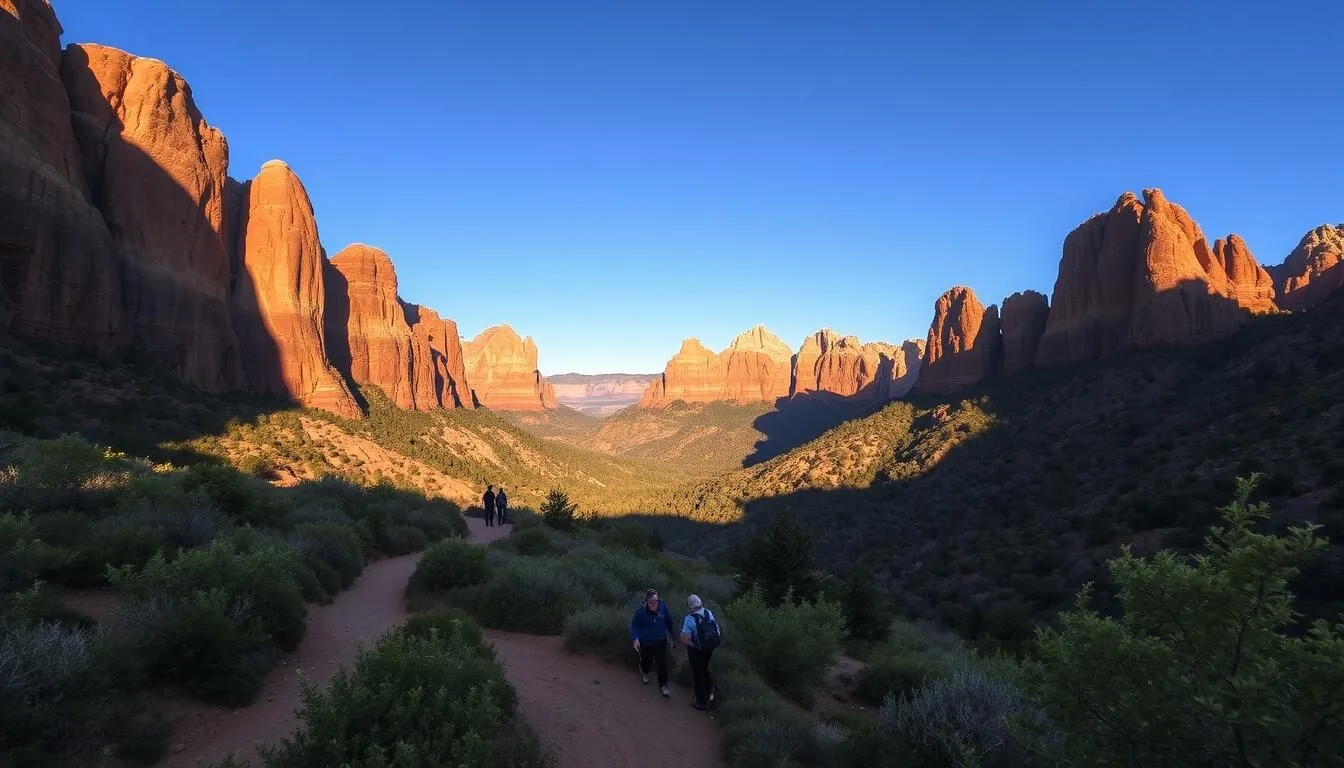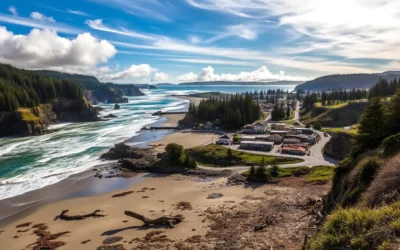Nestled in the heart of Oregon, a breathtaking landscape awaits you, featuring towering volcanic formations and the serene Crooked River. With over 650,000 visitors annually, this stunning state park has become a must-visit destination for outdoor enthusiasts.
As you plan your trip, you’ll want to know the top activities and experiences that make this park so special. From hiking trails that cater to all skill levels to scenic viewpoints that will leave you in awe, this comprehensive guide will help you make the most of your visit.
Get ready to explore one of Oregon’s most spectacular natural wonders and create unforgettable memories.
Discovering Smith Rock State Park
As you step into Smith Rock State Park, you’re immediately surrounded by the vast expanse of the high desert and the park’s iconic rock formations. This stunning natural area is a haven for outdoor enthusiasts and nature lovers.
Location and Geography
Smith Rock State Park is located in Terrebonne, Oregon, approximately 26 miles northeast of Bend and three hours southeast of Portland. The park is easily accessible via Highway 97, making it a convenient destination for day trips from major Oregon cities.
Spanning around 650 acres of high desert terrain, the park features dramatic rock formations that rise impressively from the Crooked River canyon floor. The unique geography includes towering volcanic tuff and basalt cliffs that reach heights of up to 800 feet, creating a striking contrast against the high desert landscape.
The park’s location in Oregon’s high desert means visitors experience a different climate than the state’s more famous lush, green regions. Juniper trees, sagebrush, and other desert vegetation dominate the landscape, adding to the park’s natural beauty.
Discovering Smith Rock State Park
As you plan your visit to Smith Rock State Park, understanding its geological formation and history can enhance your appreciation of this natural wonder. The park is renowned for its dramatic rock formations, which tell a fascinating story of volcanic activity that spans millions of years.
Geological Formation and History
Smith Rock is one of Oregon’s unique geologic stories. The rock formations involve two different volcanic events separated by millions of years. The first was an explosion 29 million years ago that created a massive caldera miles wide. This explosion sent out huge amounts of ash and rhyolitic lava.
Most of the rock on the north side of the Crooked River is tuff, a type of rock made from compressed ash and pumice. You can observe the varied colors and embedded rocks within the tuff formations, including pieces of limestone thought to be part of the original bedrock disrupted by volcanic activity.
- The dramatic formations at Smith Rock State Park tell a fascinating geological story spanning millions of years of volcanic activity in Central Oregon.
- The park’s iconic rock formations were created approximately 29 million years ago when a massive volcanic explosion formed a caldera miles wide, extending as far as Prineville.
- The southern section of the park features a contrasting geological story, with basalt plateaus formed by lava flows from Newberry Volcano approximately 400,000 years ago, which changed the course of the Crooked River to its present position.
Understanding this complex geological history can enrich your visit to Smith Rock State Park, allowing you to appreciate the unique landscapes and features that make it so remarkable.
Planning Your Visit to Smith Rock State Park
When planning your trip to Smith Rock State Park, timing is everything. The park offers a unique experience throughout the year, but some seasons are more favorable than others.
Best Times to Visit
The best time to visit Smith Rock is in the spring and the fall, when temperatures are pleasant and the park is less chaotic than in the busy summer. During these seasons, you can enjoy moderate temperatures and fewer crowds, making your visit more enjoyable.
- Spring (April to June) and fall (September to October) offer the most pleasant conditions for visiting Smith Rock State Park, with moderate temperatures and fewer crowds.
- Visiting in the spring rewards you with blooming wildflowers and lush vegetation throughout the park, creating a colorful contrast against the rock formations.
- Fall brings stunning autumn colors to the landscape and comfortable hiking temperatures, plus you can visit nearby pumpkin patches for a quintessential Oregon fall experience.
- Summer days at Smith Rock can be extremely hot, often exceeding 100°F with minimal shade on most trails, making early morning or evening visits essential during this season.
- Visiting in the winter provides a unique experience with occasional snow-dusted landscapes and significantly fewer visitors, though you should be prepared for potentially icy trail conditions and colder temperatures.
By considering the best times to visit Smith Rock State Park, you can plan a more enjoyable and stress-free trip. Whether you prefer the mild weather of spring and fall, or the unique experiences offered by summer and winter, Smith Rock has something to offer for every visitor.
Planning Your Visit to Smith Rock State Park
Before you head out to explore Smith Rock State Park, it’s essential to know the park’s fees and operating hours. Understanding these details will help you plan your day effectively and ensure that you make the most of your visit.
Park Fees
A day-use fee of $5 per vehicle is required to park within the Smith Rock State Park boundaries. This fee is payable at self-service fee stations located in the parking areas. For those who plan to visit frequently, an annual Oregon State Parks Pass is available for $30, providing unlimited access to all state parks for a full year.
Park Hours
Smith Rock State Park is open year-round from dawn until dusk, seven days a week, typically operating between 7 a.m. and 7 p.m. The park maintains consistent hours throughout the seasons, though daylight hours naturally vary from summer to winter, affecting how long you can explore. It’s highly recommended to arrive early, especially during peak visiting days like weekends and holidays, as parking lots can fill up quickly.
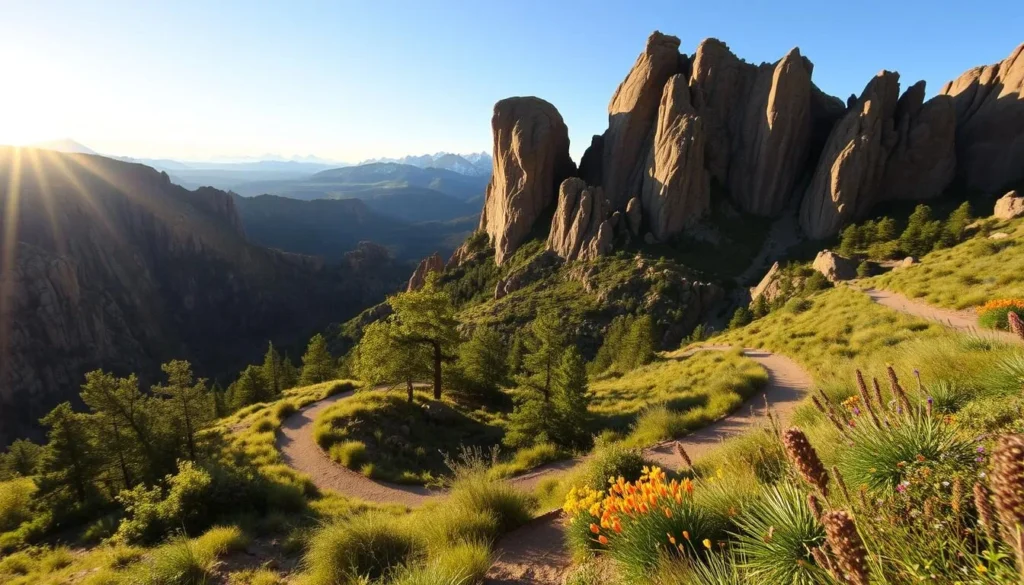
- The park is open 7 days a week.
- An annual Oregon State Parks Pass is available for frequent visitors.
- Daylight hours vary by season.
By being aware of these details, you can better plan your trip to Smith Rock and enjoy the beautiful landscapes and activities it has to offer.
Essential Tips for Visiting Smith Rock State Park
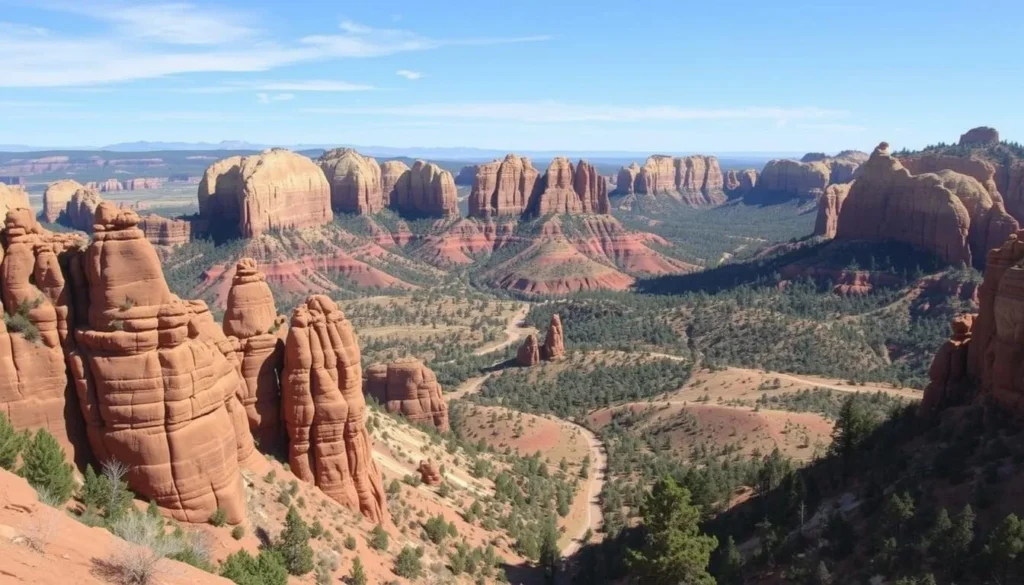
Smith Rock State Park’s rugged terrain demands careful preparation and the right equipment. As you plan your visit, especially if you’re hiking the Misery Ridge Trail, it’s essential to know what to bring to ensure a safe and enjoyable experience.
What to Bring
When hiking at Smith Rock State Park, it’s vital to carry enough water to stay hydrated, especially during the steep uphill march back to the parking lot. Although there’s a water spigot behind the Welcome Center, it’s not always functional.
Bringing the right gear is crucial. Here are some essentials:
- Bring more water than you think you’ll need, especially during summer months when temperatures soar and most trails offer little shade.
- Wear sturdy hiking shoes or boots with good traction to navigate the park’s rocky, sometimes steep terrain safely.
- Pack sun protection, including sunscreen, sunglasses, and a wide-brimmed hat, as the high desert environment offers minimal natural shade.
- Obtain a detailed trail map available at the Welcome Center or downloadable from the Oregon State Parks website to navigate the interconnected trail system.
- Consider bringing trekking poles for the steeper sections, particularly for the challenging ascent and descent of Misery Ridge.
- Don’t forget your camera to capture the spectacular views.
By being well-prepared, you can fully enjoy the beauty and adventure that Smith Rock has to offer.
Essential Tips for Visiting Smith Rock State Park
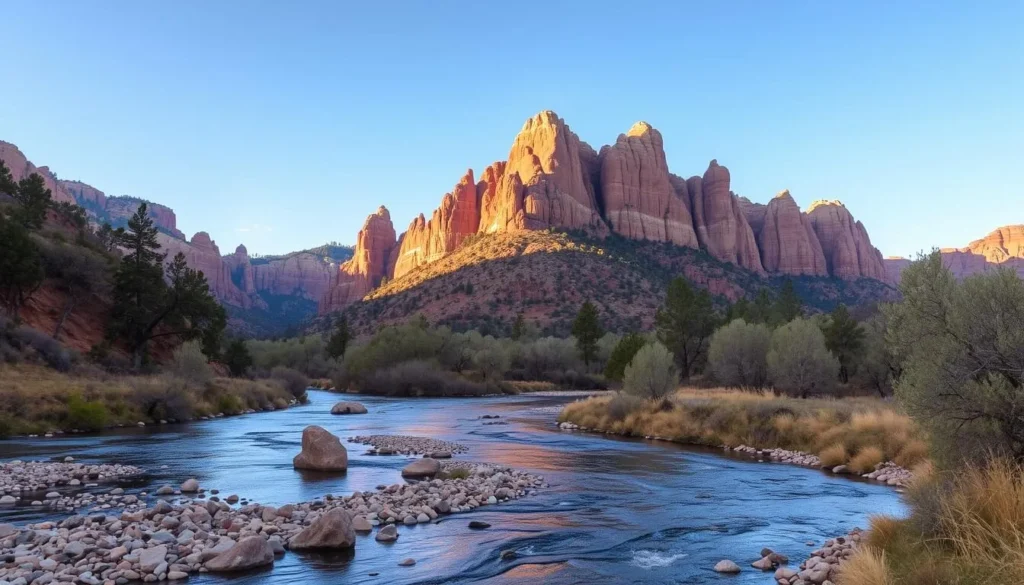
As you plan your visit to Smith Rock State Park, it’s crucial to be aware of the safety considerations to ensure a enjoyable and safe hiking experience.
Safety Considerations
When hiking at Smith Rock State Park, particularly on the River Trail, there are several safety considerations to keep in mind. The park is home to rattlesnakes, especially during the morning hours when they are more likely to be sunning themselves on the trails.
To stay safe, be alert for rattlesnakes on the trails and maintain a safe distance. It’s also essential to stay on established paths and avoid wandering into dense vegetation.
- Be alert for rattlesnakes on the trails, particularly during morning hours when they may be sunning themselves—maintain a safe distance and stay on established paths.
- Watch the weather forecast before your visit, as extreme heat in summer or icy conditions in winter can create hazardous hiking conditions.
- Tell someone your planned route and expected return time, especially if hiking alone or tackling more challenging trails like Misery Ridge.
- Carry a basic first aid kit for minor injuries, as cell service can be spotty in some areas of the park.
- Stay hydrated and pace yourself, particularly when hiking during hot weather—heat exhaustion and dehydration are common issues for unprepared visitors.
Additionally, be prepared for the weather conditions. There is very little shade on the hiking trails at Smith Rock, and summer days get hot. Wear sunscreen and bring more water than you think you’ll need. In winter, trails can receive snow and ice, making microspikes helpful for traction.
Smith Rock State Park, Oregon: Best Things to Do – Top Picks
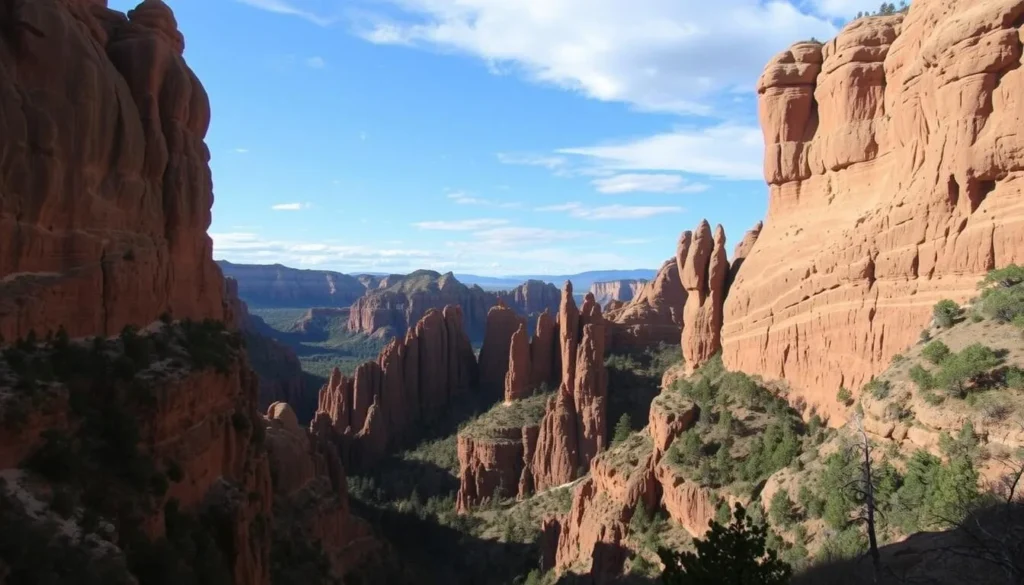
Smith Rock State Park, Oregon, is renowned for its stunning natural beauty and varied activities, making it an ideal getaway. Whether you’re an avid rock climber, a hiker, or a nature enthusiast, this park has something for everyone.
Overview of Activities
Smith Rock State Park offers a diverse range of activities beyond its famous rock climbing. Visitors can enjoy hiking, photography, mountain biking, wildlife viewing, and picnicking. The park’s extensive network of trails accommodates all skill levels, from easy riverside strolls to challenging summit ascents that reward you with panoramic views.
The park is particularly famous among rock climbing enthusiasts, who flock to the park for its world-class routes. Smith Rock is considered the birthplace of American sport climbing and features over 1,800 climbing routes of varying difficulties. The dramatic rock formations, the winding Crooked River, and diverse wildlife create perfect subjects for photography in changing light conditions.
- Smith Rock State Park offers a diverse range of activities beyond its famous rock climbing, including hiking, photography, mountain biking, wildlife viewing, and picnicking.
- Rock climbing enthusiasts flock to the park for its world-class routes—Smith Rock is considered the birthplace of American sport climbing and features over 1,800 climbing routes of varying difficulties.
- The extensive network of hiking trails accommodates all skill levels, from easy riverside strolls to challenging summit ascents that reward you with panoramic views.
- Photography opportunities abound throughout the park, with dramatic rock formations, the winding Crooked River, and diverse wildlife creating perfect subjects in changing light conditions.
- Birdwatching is particularly rewarding at Smith Rock, where you might spot golden eagles, prairie falcons, and various songbirds nesting in the cliff faces or soaring above the canyon.
With its rich natural beauty and diverse recreational opportunities, Smith Rock State Park is a must-visit destination for outdoor enthusiasts. Whether you’re looking to challenge yourself on the climbing routes or simply enjoy the scenery, the park provides an unforgettable experience.
Smith Rock State Park, Oregon: Best Things to Do – Top Picks
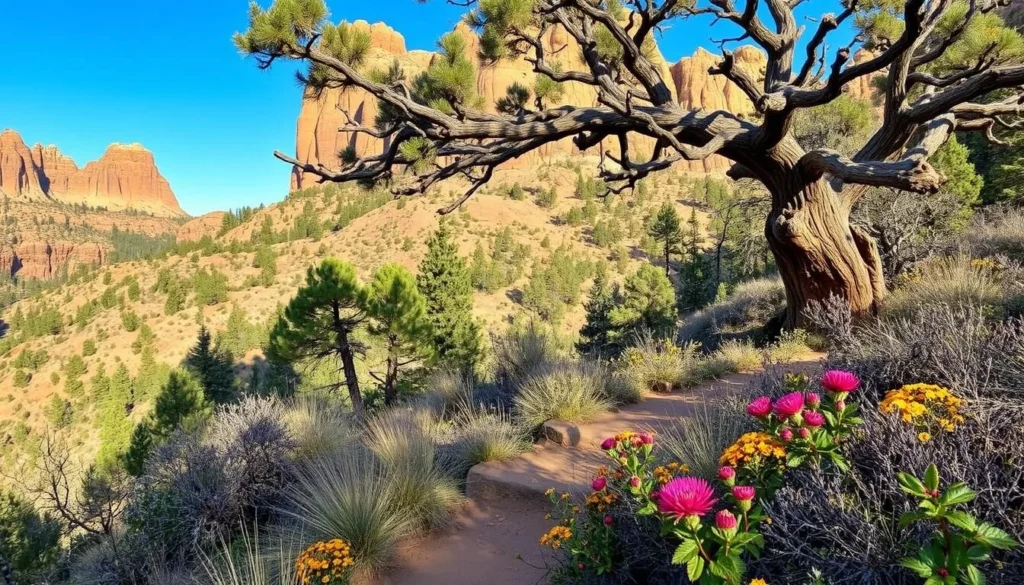
With only 650 acres to explore, Smith Rock State Park can be experienced in a day, but a weekend allows for a more leisurely pace. To make the most out of your visit, planning is key.
Creating Your Itinerary
To ensure a memorable trip, consider the following tips when creating your itinerary for Smith Rock:
- Plan to spend at least a full day at Smith Rock State Park to experience its highlights, though a weekend allows for a more relaxed exploration of the various trails and viewpoints.
- Start your visit at the Welcome Center to get oriented with trail maps and current park conditions before heading down into the canyon.
- For a well-rounded day trip, combine a morning hike on one of the signature trails like Misery Ridge with afternoon exploration of the riverside paths when temperatures are typically higher.
- If you’re visiting for multiple days, consider dedicating one day to the southern section of the park (Misery Ridge, River Trail) and another to the northern areas (Wolf Tree Trail, North Point).
- Factor in extra time for photography stops, wildlife viewing, and rest breaks, especially if you’re tackling the more strenuous trails in the park.
By following these guidelines, you can create an itinerary that allows you to fully appreciate the beauty and adventure that Smith Rock State Park has to offer. Whether you’re hiking the trails or simply enjoying the views, your visit will be memorable.
Hiking the Misery Ridge Trail
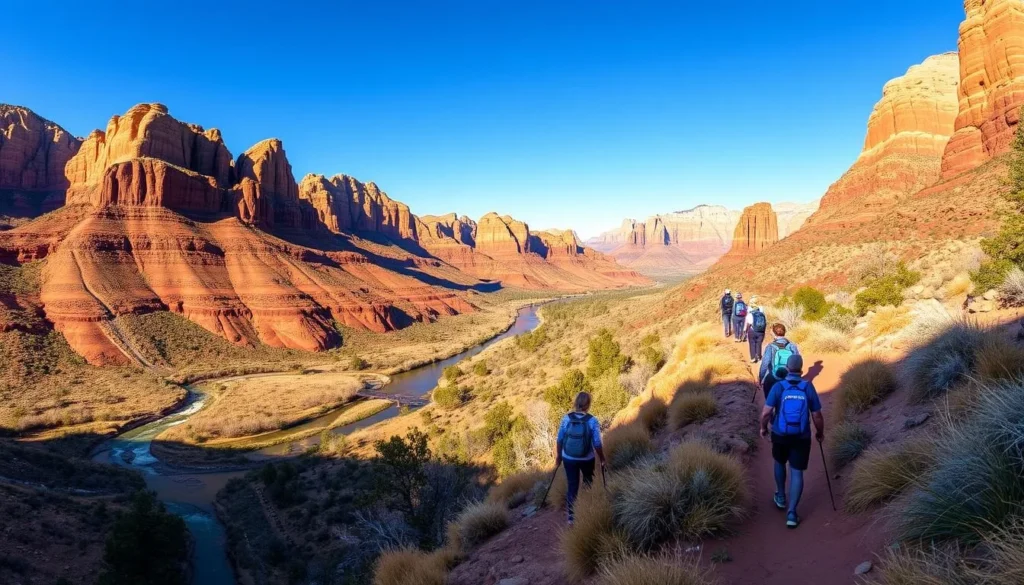
Discover the thrill of hiking the Misery Ridge Trail, Smith Rock’s signature hiking experience that promises unparalleled panoramic views. This challenging trail is not for the faint of heart, but the rewards are well worth the effort.
Trail Details and Difficulty
The Misery Ridge Trail is a 2.2-mile round-trip hike with a significant elevation gain of 1,115 feet, making it a strenuous hard difficulty trail. The trail features numerous switchbacks as you ascend from the Crooked River Bridge to the summit.
- The trail covers 2.2 miles round-trip with a challenging elevation gain that rewards you with panoramic views.
- This strenuous trail gains over 1,000 feet in elevation in just one mile of hiking.
- Despite its difficulty rating, the trail is accessible to moderately fit hikers who pace themselves.
- The trail surface consists of packed dirt and rock steps, requiring sturdy footwear.
- You can hike Misery Ridge as an out-and-back trail or combine it with other trails like the River Trail for a 3.5-mile loop.
As you hike the Misery Ridge Trail, you’ll be treated to breathtaking views of Smith Rock State Park and the Crooked River. It’s an experience that combines physical challenge with natural beauty, making it a must-do for any outdoor enthusiast visiting the park.
Hiking the Misery Ridge Trail
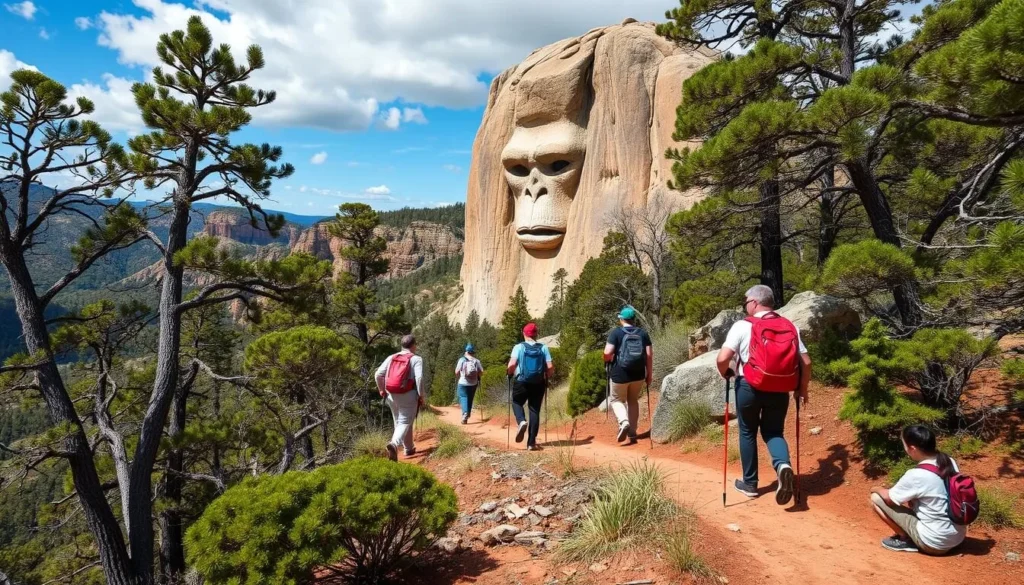
As you embark on the Misery Ridge Trail, get ready for an unforgettable hiking experience. The trail is known for its challenging terrain and breathtaking views.
What to Expect on the Trail
Just be sure to bring along some sunscreen and plenty of water—besides just having seemingly never-ending switchbacks to the endpoint, the Misery Ridge Trail is also almost totally exposed to the sun. The views at the top are nothing short of epic.
As you ascend Misery Ridge, you’ll be treated to increasingly spectacular views of the surrounding landscape, including the Cascade Mountain Range with peaks like Three Sisters and Mount Jefferson visible on clear days.
- The trail is almost entirely exposed to the sun with minimal shade, making early morning or late afternoon the most comfortable times to tackle this hike, especially during summer months.
- At the summit, you’ll enjoy 360-degree views of the entire park, including the iconic Monkey Face rock formation, the winding Crooked River below, and the dramatic volcanic spires of the Monument area.
- Watch for rock climbers scaling the sheer cliff faces along your trail—Misery Ridge offers some of the best vantage points to observe climbers tackling challenging routes.
- The descent from the summit can be as challenging as the climb up, with loose gravel in some sections requiring careful footing and attention to the trail.
Exploring the River Trail
Meandering along the Crooked River, the River Trail at Smith Rock State Park offers a unique and unforgettable experience. This trail is designed for those who seek a more relaxed hiking experience, with a distance of 2.5 miles and minimal elevation gain of about 200 feet, making it easy and accessible for hikers of all skill levels.
Trail Highlights and Features
The River Trail is a scenic path that snakes along between the Crooked River and the canyon wall, taking you through diverse landscapes including fields of sagebrush, wildflowers, and pine tree forests. Along the way, you’ll have the opportunity to observe the changing seasons and enjoy the unique perspectives of Smith Rock’s dramatic formations from below.
The trail features diverse micro-environments, including sagebrush meadows, ponderosa pine groves, and riverside vegetation. This variety not only enhances the hiking experience but also provides excellent opportunities for wildlife viewing, making it a great spot for nature enthusiasts.
- The River Trail offers a gentle hiking experience, making it suitable for families and hikers of all skill levels.
- It follows the meandering Crooked River, providing unique views of Smith Rock’s formations.
- The trail passes through diverse landscapes, including sagebrush meadows and pine forests.
- It serves as a connector route, allowing hikers to link to other trails or create a loop with more challenging routes.
- The reflections of the rock formations in the Crooked River create stunning photo opportunities, especially during early morning or late afternoon.
As you hike along the River Trail, be sure to keep your camera ready to capture the breathtaking views and reflections in the Crooked River. The trail’s easy difficulty and scenic beauty make it an ideal choice for a leisurely hike in Smith Rock State Park.
Exploring the River Trail
Exploring the River Trail means immersing yourself in the natural habitat of various species that call Smith Rock State Park home. As you walk along this scenic trail, you’re likely to encounter a variety of wildlife that inhabit the area around the Crooked River.
Wildlife Viewing Opportunities
The River Trail provides some of the best wildlife viewing opportunities in Smith Rock State Park. You might catch a glimpse of mule deer grazing near the riverbank or beavers swimming in the water. The trail is also a haven for birdwatchers, with species such as golden eagles and prairie falcons often spotted soaring above the canyon or nesting on the cliff faces.
To make the most of your wildlife viewing experience, it’s recommended to bring binoculars to get a closer look at the birds and other animals without disturbing them. The River Trail is particularly appealing due to its riparian environment, which attracts a variety of waterfowl and songbirds.
While enjoying the wildlife, it’s essential to be aware of your surroundings, especially when it comes to rattlesnakes that might be sunning themselves on or near the trail. Maintaining a safe distance and never attempting to handle or disturb them is crucial.
As you explore the River Trail, remember to look up and appreciate the rock climbers scaling the canyon walls. This adds a dynamic human element to the natural scenery, making your experience even more memorable.
- The River Trail is home to a diverse range of wildlife, including mule deer, river otters, and beavers.
- Birdwatchers can spot golden eagles and prairie falcons, especially with the use of binoculars.
- The riparian environment along the Crooked River attracts various waterfowl and songbirds.
- Be cautious of rattlesnakes on or near the trail, especially during morning hours.
- Don’t forget to look up and enjoy the rock climbers on the canyon walls.
Conquering the Canyon Trail and The Chute
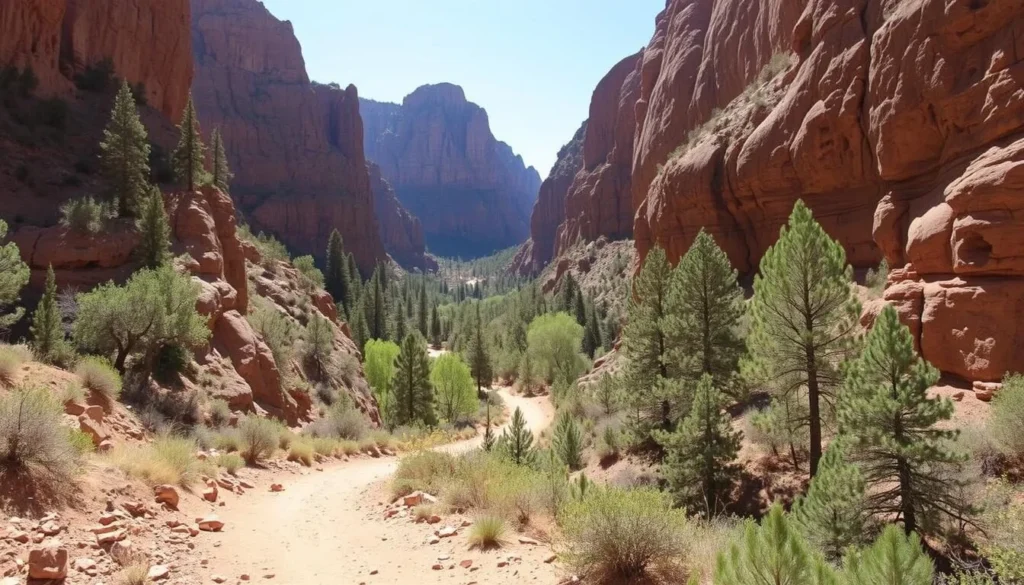
Smith Rock State Park’s Canyon Trail is a fantastic trail that combines natural beauty with accessibility. As you explore this trail, you’ll discover why it’s considered one of the park’s best beginner trails.
Trail Characteristics
The Canyon Trail extends for 3.1 miles with a modest elevation gain of 180 feet, offering an accessible hiking experience that’s perfect for beginners and families visiting Smith Rock State Park. This trail runs along the opposite side of the Crooked River from the more popular River Trail, providing superior views of the towering rock walls and the river from a different perspective.
Some key features of the Canyon Trail include:
- The trail passes through shaded pine forests, offering welcome relief from the sun during hot summer days.
- The trail surface is generally well-maintained and less rocky than some other paths in the park, making it more approachable for those with less hiking experience or families with children.
- You can easily combine the Canyon Trail with other routes like the Rope de Dope Trail and Rim Rock Trail to create a varied loop hike that showcases different aspects of the park’s landscape.
By understanding the characteristics of the Canyon Trail, you can better plan your visit to Smith Rock State Park and enjoy the natural beauty it has to offer.
Conquering the Canyon Trail and The Chute

The Canyon Trail, located on the opposite side of the Crooked River, provides a unique perspective on the park’s dramatic rock formations. As you hike along this trail, you’ll be treated to unobstructed vistas of the river and the towering walls that surround it.
Best Views and Photo Spots
The Canyon Trail offers some of the most photogenic views in Smith Rock State Park. With its diverse landscape, including pine forests, river scenes, and rock formations, photographers will have a wide range of compositions to work with.
- Unobstructed Vistas: The trail provides perfect views of the dramatic rock formations rising directly from the Crooked River.
- Natural Viewpoints: Several natural viewpoints along the trail offer ideal photo opportunities to capture the contrast between the flowing river, towering rock walls, and blue Oregon skies.
- Diverse Landscape: The varied landscape along the Canyon Trail includes pine forests, river scenes, and rock formations, giving photographers a diverse range of compositions to work with.
- Optimal Lighting: Morning light illuminates the eastern faces of the rock formations, while afternoon and evening light bathes the western aspects in a warm glow—plan your hike timing according to your photography goals.
- Reflections: Look for reflections of the rock formations in calm sections of the Crooked River, which can create stunning mirror images, especially during early morning hours when the water is typically most still.
As you explore the Canyon Trail and The Chute, be sure to take in the breathtaking views of Smith Rock and the surrounding landscape. With its unique combination of natural beauty and exciting hiking opportunities, this trail is a must-visit destination within the park.
Venturing on the Wolf Tree Trail
If you’re looking for a less crowded trail in Smith Rock State Park, the Wolf Tree Trail is an excellent choice. This scenic trail offers a unique hiking experience with its varied terrain and stunning views.
Trail Experience and Scenery
The Wolf Tree Trail extends 2.7 miles with a moderate elevation gain of 406 feet, making it an ideal hike for those looking for a manageable challenge. As you hike along the trail, you’ll follow the Crooked River northward, providing unique perspectives of the Monument, one of the park’s most dramatic rock formations.
- The trail takes you through varied terrain, including riverside paths, juniper groves, and open areas with expansive views of the northern section of the park.
- The Wolf Tree Trail is named after a distinctive, gnarled juniper tree that stands as a landmark along the route.
- You can hike the Wolf Tree Trail as an out-and-back experience or combine it with Burma Road and other connecting trails to create longer loop options.
The Wolf Tree Trail offers a serene hiking experience, with its distance of 2.7 miles and elevation gain of 406 feet making it an easy to moderate hike. As you explore the trail, you’ll be surrounded by the natural beauty of Smith Rock State Park, making it a must-visit destination for outdoor enthusiasts.
Venturing on the Wolf Tree Trail
The Wolf Tree Trail is more than just a standalone path; it’s a crucial connector to other trails in Smith Rock’s northern section, allowing you to customize your hiking experience based on your time and fitness level.
Trail Connections
The Wolf Tree Trail serves as an excellent link to other paths within the park. You can choose to hike it as an out-and-back trail, turning around at the Monument, or extend your adventure by connecting to the Burma Road Trail or incorporating it into a larger loop with the Misery Ridge Trail.
One of the key benefits of the Wolf Tree Trail is its ability to be combined with other trails, creating a variety of hiking options. For instance, you can form a loop by combining the Wolf Tree Trail with the Summit Trail and Misery Ridge, resulting in a comprehensive 6-7 mile hike that showcases the park’s diverse landscapes.
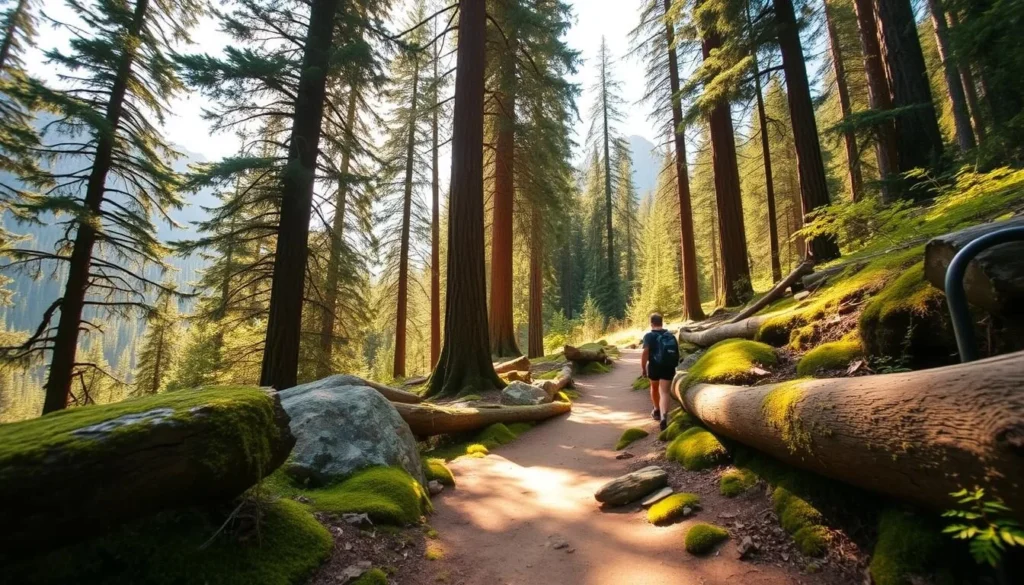
The junction points between the Wolf Tree Trail and other trails are well-marked with directional signage, making it easy for visitors, including first-timers, to navigate the park’s trail system.
- The trail offers a flexible hiking experience, allowing you to adjust your route based on your preferences and physical condition.
- By connecting to Burma Road Trail, you can enjoy higher elevation views that span across the entire park.
- Using the Wolf Tree Trail as part of a multi-day exploration plan enables you to experience different sections of the park’s trail system without overexertion.
Whether you’re looking for a short, leisurely hike or an extended, more challenging adventure, the Wolf Tree Trail’s connectivity to other trails makes it an ideal choice for a wide range of visitors to Smith Rock State Park.
Discovering the Rim Rock and North Point Trails
As you explore Smith Rock State Park, you’ll discover two trails that stand out for their accessibility and breathtaking views: the Rim Rock Trail and the North Point Trail. These trails offer a unique opportunity to experience the park’s natural beauty with ease.
Trail Characteristics
The Rim Rock Trail is a 1.0-mile path that follows the rim of the canyon, providing spectacular views of the Crooked River and the surrounding rock formations. With an elevation gain of just 22 feet, this trail is considered easy and is suitable for hikers of all abilities.
The North Point Trail, on the other hand, is a 0.5-mile loop that offers a less-crowded alternative with equally impressive views of the park’s geological features. This trail has minimal elevation change, making it an ideal choice for those looking for a relaxed hiking experience.
- The Rim Rock Trail features a wide, gravel-packed surface, making it wheelchair-accessible and suitable for strollers or those with mobility issues.
- Both trails offer panoramic views of the park’s dramatic landscapes, including the Crooked River and the Cascade Mountains on clear days.
- Strategically placed benches at viewpoints allow visitors to rest and fully appreciate the scenery.
- The trails are particularly appealing during sunrise or sunset, when the changing light creates dramatic shadows and colors on the rock formations.
- These easy trails are perfect for families or those looking for a leisurely hike that still offers the chance to experience the best of Smith Rock State Park.
Whether you’re looking for a relaxing hike or simply want to take in the views, the Rim Rock and North Point Trails at Smith Rock State Park are must-visit destinations. With their easy terrain and spectacular views, these trails provide an unforgettable experience for visitors of all ages and abilities.
Discovering the Rim Rock and North Point Trails
The Rim Rock and North Point Trails at Smith Rock State Park are perfect for a family day out, offering easy hiking and educational opportunities. These trails are ideal for families visiting the park, with gentle terrain that’s manageable for children and spectacular views that engage visitors of all ages.
Family-Friendly Features
These trails feature educational signage about the park’s geology, wildlife, and history, creating natural learning opportunities for young explorers. Unlike many of Smith Rock‘s more challenging hiking trails, these paths don’t require descending into and climbing back out of the canyon, making them perfect for visitors with limited mobility or families with strollers.
- The trails are accessible to all kinds of hikers and offer views of the park’s most iconic formations.
- The Rim Rock Trail is a great introductory hike, while the North Point Trail is a less crowded option with a wheelchair-accessible crushed gravel path.
- The proximity to the main parking area and Welcome Center means convenient access to restrooms, picnic areas, and water sources.
Look for the mini climbing wall near the Welcome Center adjacent to the Rim Rock Trail, where young visitors can safely experience a taste of Smith Rock‘s famous climbing opportunities. This feature, combined with the trails’ accessibility, makes Smith Rock State Park an excellent destination for families.
Rock Climbing Adventures at Smith Rock
Smith Rock State Park has earned its reputation as the birthplace of American sport climbing, offering a diverse range of climbing experiences. With nearly 2,000 established routes, it caters to climbers of all skill levels, from beginners to seasoned experts.
Famous Climbing Routes
The park is home to some of the most iconic climbing routes in the country. Monkey Face, a 350-foot freestanding pillar, is one of the most recognizable landmarks and features the challenging “Just Do It” route (5.14c). This route was one of the first of its difficulty in the United States when established in 1992.
Other notable areas include Morning Glory Wall, which offers moderate routes with excellent rock quality and varied climbing styles, making it ideal for intermediate climbers. The Red Wall area is known for its distinctive dark red volcanic tuff and hosts challenging multi-pitch routes that attract experienced climbers.
- Smith Rock State Park is revered as the birthplace of American sport climbing, with nearly 2,000 established routes.
- The varied rock composition throughout the park creates diverse climbing experiences, including crack climbing on basalt columns and technical face climbing on volcanic tuff formations.
The diversity in rock formations and climbing routes makes Smith Rock State Park a unique destination for rock climbing enthusiasts. Whether you’re looking to tackle challenging ascents or enjoy more leisurely climbs, Smith Rock has something to offer.
Rock Climbing Adventures at Smith Rock
Guided climbing tours are an excellent way to explore Smith Rock State Park’s renowned rock formations. With numerous professional guiding services operating within the park, you can find the perfect guide to suit your climbing needs.
Certified Climbing Guides
Several professional guiding services operate at Smith Rock State Park, offering instruction and guided climbs for beginners and experienced climbers looking to improve their skills. Smith Rock Climbing School and Chockstone Climbing Guides provide certified instructors who can teach fundamental climbing techniques while ensuring safety on the rock.
- Guided climbing experiences typically include all necessary equipment, making them accessible for visitors who don’t have their own gear.
- Most guide services offer a variety of programs ranging from half-day introductory sessions to multi-day advanced climbing courses tailored to different skill levels.
- Booking a guided climbing experience in advance is highly recommended, especially during peak seasons (spring and fall), when these services can fill up quickly.
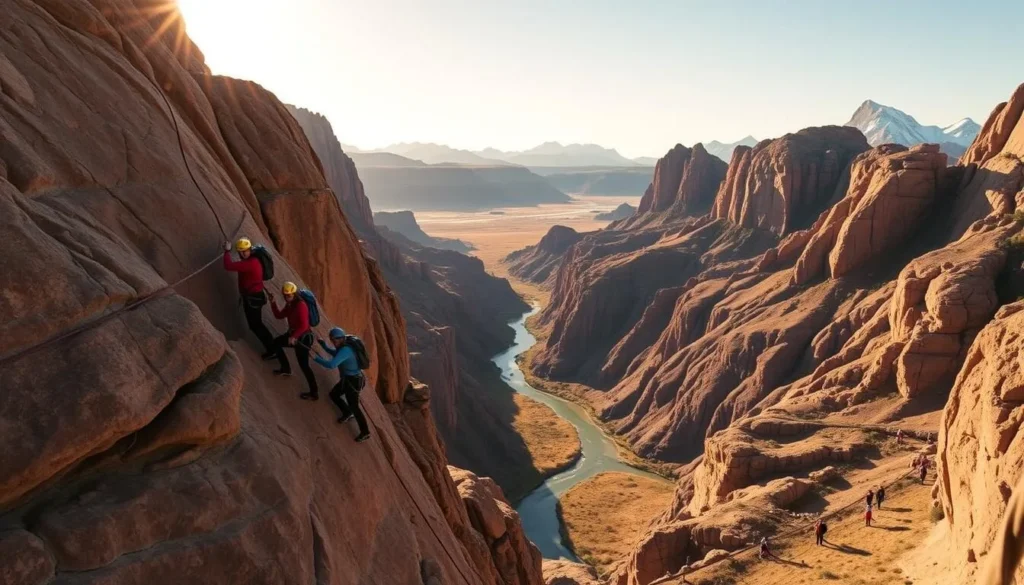
By choosing a guided tour, you can enjoy a safe and memorable climbing adventure at Smith Rock, exploring its iconic climbing routes with expert guidance.
Photography Opportunities in the Park
As you explore Smith Rock State Park, you’ll discover a plethora of photography opportunities that showcase the park’s breathtaking landscapes. The park’s unique combination of rugged rock formations, the sinuous Crooked River, and the high desert terrain creates a photographer’s paradise.
Best Viewpoints
The Rim Rock Trail is a standout location for capturing the perfect shot, particularly during sunrise and sunset when the sky is painted with vibrant hues. The trail offers panoramic vistas of the entire canyon and rock formations from an elevated perspective, making it an ideal spot for landscape photography.
Some of the top viewpoints in the park include:
- The Rim Rock Trail, which offers spectacular views of the canyon and rock formations
- The Crooked River Bridge area, providing unique low-angle views of the towering rock faces
- The summit of Misery Ridge, with its 360-degree views encompassing the entire park and the distant Cascade Mountains
The contrast between the rugged rock formations and the serene Crooked River creates compelling compositional opportunities throughout the park. The soft light of early morning or late afternoon is particularly conducive to capturing stunning photographs.
| Location | Best Time to Visit | Photography Opportunities |
|---|---|---|
| Rim Rock Trail | Sunrise, Sunset | Panoramic vistas, dramatic lighting |
| Crooked River Bridge | Early morning, Late afternoon | Low-angle views, flowing water |
| Misery Ridge Summit | Anytime | 360-degree views, landscape photography |
By visiting these viewpoints and taking advantage of the park’s natural beauty, you can capture truly unforgettable photographs that showcase the essence of Smith Rock State Park.
Photography Opportunities in the Park
As the day begins or ends, Smith Rock State Park transforms into a photographer’s paradise, with the Crooked River adding a serene touch to the dramatic landscape. The park’s unique landscape, featuring volcanic tuff formations and the high desert scenery, offers endless opportunities for capturing stunning photographs.
Sunrise and Sunset Photography
Smith Rock State Park is renowned for its breathtaking sunrises and sunsets, which paint the sky with vibrant colors, creating a dramatic backdrop for photography. The golden hour, just before sunrise and after sunset, is particularly prized for its soft, warm light.
During sunrise, the eastern light dramatically highlights the textured surfaces of the rock formations, while the calm conditions often result in perfect reflections on the Crooked River, doubling the visual impact of the scenery. For the best sunrise shots, arrive early to secure a good vantage point, and be prepared for the cold morning temperatures typical of the high desert.
For sunset photography, the Rim Rock Trail offers accessible viewpoints where you can capture the sun sinking behind the craggy spires, painting the sky with vibrant oranges, pinks, and purples. Remember to bring a headlamp or flashlight as the trails can become difficult to navigate in diminishing light, and be prepared with extra layers as desert temperatures drop quickly after sundown.
- The park transforms during golden hour, with low-angle sunlight illuminating the volcanic tuff formations in rich, warm colors that contrast beautifully with the high desert landscape.
- Sunrise photography offers the advantage of fewer crowds and often calmer conditions, with the eastern light highlighting the rock formations.
- The Crooked River provides perfect reflections of the illuminated rock faces during calm mornings.
- For sunset, the Rim Rock Trail offers viewpoints to capture the sun behind the craggy spires.
Whether you’re capturing the sunrise or sunset, Smith Rock State Park’s unique combination of dramatic rock formations, the serene Crooked River, and the high desert landscape provides a wealth of photography opportunities. With its natural beauty and diverse scenery, Smith Rock is a must-visit destination for photographers.
Wildlife Viewing at Smith Rock State Park
The unique ecosystems within Smith Rock State Park support a wide variety of wildlife, making it a great destination for nature lovers. As you explore the park, keep an eye out for the diverse range of species that call this area home.
Common Species to Spot
When visiting Smith Rock, it’s not uncommon to see golden eagles, prairie falcons, deer, river otters, and beaver. The park’s diverse ecosystems support a variety of wildlife, and being aware of your surroundings can lead to some remarkable sightings.
The Crooked River corridor is particularly attractive to numerous species. You can often spot river otters, beavers, and muskrats swimming or foraging along the riverbanks. The Crooked River is a vital part of the ecosystem, providing a habitat for these and other species.
| Wildlife | Habitat | Best Time to Spot |
|---|---|---|
| Mule Deer | Open areas and woodlands | Early morning and evening |
| Golden Eagles and Prairie Falcons | Canyon and high cliff faces | Anytime, especially during nesting season |
| River Otters and Beavers | Crooked River and its banks | During swimming or foraging activities |
To make the most of your wildlife viewing experience, remember to stay on designated trails and keep your pets on a leash to protect both the wildlife and the park’s plant life.
As you enjoy the natural beauty of Smith Rock State Park, be mindful of the high desert environment and its inhabitants, including smaller creatures like western fence lizards and various snake species. The park is also a haven for birdwatchers, with species like canyon wrens, white-throated swifts, and various songbirds inhabiting the riparian zones and juniper woodlands.
Wildlife Viewing at Smith Rock State Park
With its diverse ecosystems, Smith Rock State Park is an ideal location for observing wildlife in their natural habitats. The park’s unique landscape, featuring the Crooked River and varied vegetation, creates a haven for a wide range of species.
Optimal Times and Locations
The best times for wildlife viewing at Smith Rock State Park are early morning and late afternoon when animals are most active and visitor traffic is typically lighter. The River Trail and Wolf Tree Trail are excellent locations, as they follow the Crooked River where many species come to drink, feed, and nest.
- Quiet observation areas along the riverbanks, especially in sections with cattails and riparian vegetation, increase your chances of spotting water-loving species like otters, beavers, and various waterfowl.
- Bringing binoculars will enhance your wildlife viewing experience, allowing you to scan the high cliff faces for nesting raptors and observe wildlife from a respectful distance without disturbing their natural behaviors.
- Seasonal variations affect wildlife viewing—spring brings nesting birds and newborn animals, while winter’s sparse vegetation can make larger mammals easier to spot against the landscape.
As you explore the park, keep in mind that the Crooked River plays a crucial role in supporting the local wildlife. The river’s presence creates a diverse range of habitats, from the riverbanks to the surrounding cliffs, supporting a wide variety of species.
By visiting Smith Rock State Park during the optimal times and exploring the recommended trails, you can enjoy a rich and rewarding wildlife viewing experience. Whether you’re observing mule deer grazing or golden eagles soaring overhead, the park offers a unique opportunity to connect with nature.
Camping Options at Smith Rock
For those looking to immerse themselves in the outdoors, Smith Rock State Park provides a camping experience like no other. The park offers a unique opportunity to connect with nature and enjoy the beautiful surroundings.
Bivouac Campground
The Bivouac Campground at Smith Rock State Park is a rustic, walk-in tent camping experience. It’s a first-come, first-served campground, and visitors can obtain a camping permit at the fee station located at the entrance to the camping area.
- The campground charges $8 per person per night.
- Facilities include potable water, restrooms with flush toilets, hot showers for overnight guests, and a communal cooking area with picnic tables.
- Due to the park’s high desert climate and fire risk, campfires are strictly prohibited at the Bivouac Campground.
- The campground is typically open from early spring through late fall, depending on weather conditions, and can fill quickly during summer weekends and holidays.
Camping at Smith Rock allows you to be surrounded by the natural beauty of the park. The Bivouac Campground is designed to provide a basic yet fulfilling camping experience, with the necessary amenities to make your stay comfortable.
When planning your visit, keep in mind that the campground operates on a first-come, first-served basis. This means that arriving early, especially during peak summer days, is crucial to securing a spot.
Overall, the Bivouac Campground at Smith Rock State Park is an excellent choice for those looking to experience the park’s natural beauty up close.
Camping Options at Smith Rock
If you’re looking for more camping options near Smith Rock State Park, there are several alternatives to consider. While the park’s camping facilities are limited, the surrounding area offers a range of options to suit different needs and preferences.
Alternative Campgrounds
For those who prefer more spacious camping or RV-friendly facilities, nearby campgrounds are a great option. Skull Hollow Campground, located just a few miles northeast of Smith Rock State Park on Lone Pine Road, offers sites that accommodate RVs and car camping. This USFS campground provides a more primitive experience with vault toilets and no running water, but allows campfires when seasonal restrictions aren’t in place.
- Crooked River Ranch RV Park provides full hookup sites approximately 10 miles from Smith Rock, offering amenities like showers and laundry facilities.
- The Redmond/Central Oregon KOA, about 10 miles south of Smith Rock, offers a range of camping options from tent sites to full RV hookups, plus amenities like a pool during summer months.
- The Cove Palisades State Park campground, about 30 minutes away, offers beautiful lakeside camping with full facilities, making it a good option for families or those planning a longer stay.
These nearby camping alternatives offer a range of choices for visitors to Smith Rock State Park, ensuring that you can find the perfect spot to suit your needs.
Where to Stay Near Smith Rock State Park
If you’re heading to Smith Rock State Park, you’ll find that Terrebonne has a variety of accommodations to suit your needs. Located in Oregon, Terrebonne is just a short drive from the park, making it an ideal base for your adventure.
Accommodations in Terrebonne
Terrebonne offers a range of lodging options that cater to different preferences and budgets. You can choose from:
- Ranch at the Canyons: This upscale lodging is situated on a 1,700-acre private ranch adjacent to Smith Rock State Park. The luxurious townhomes offer stunning views of the park’s rock formations, providing a unique and memorable experience.
- Private Vacation Rentals and Guest Houses: Terrebonne has several private vacation rentals and guest houses that provide home-like accommodations. These often come with full kitchens and outdoor spaces, making them ideal for longer stays or family groups.
- Smith Rock State Park B&B: For a more personalized experience, the Smith Rock State Park B&B offers charming rooms with views of the park and homemade breakfasts. It’s located just a mile from the park entrance, ensuring maximum convenience.
It’s worth noting that most accommodations in Terrebonne require advance reservations, especially during peak seasons (spring and fall). Planning ahead will ensure that you secure your preferred lodging and can make the most of your visit to Smith Rock State Park.
When planning your trip, consider the distance from your accommodation to the park. While Terrebonne offers the closest options, Redmond is also a viable choice, being only a 13-minute drive to the park. This allows for a bit more flexibility in your accommodation choices while still being conveniently located.
By choosing to stay in Terrebonne, you’ll be able to start your day early and make the most of your time at Smith Rock State Park. With its convenient location and variety of accommodations, Terrebonne is the perfect place to base your adventure.
Where to Stay Near Smith Rock State Park
When planning your trip to Smith Rock State Park, consider staying in nearby Redmond or Bend for a comfortable and enjoyable experience. Both towns offer a range of accommodations to suit different preferences and budgets.
Lodging Options in Redmond and Bend
Redmond, just 7 miles south of Smith Rock State Park, offers a variety of accommodation options, including chain hotels like Hampton Inn & Suites and SCP Redmond Hotel. These hotels provide modern amenities and comfortable stays.
| City | Hotel | Amenities |
|---|---|---|
| Redmond | Hampton Inn & Suites | Free Breakfast, Pool |
| Redmond | SCP Redmond Hotel | Fitness Center, Restaurant |
| Bend | Oxford Hotel | Eco-friendly, Central Location |
| Bend | Tetherow Hotel | Golf, Multiple Dining Options |
Bend, located about 26 miles south of the park, provides the most diverse lodging options, from luxury resorts to budget-friendly motels and hostels. The Oxford Hotel in downtown Bend offers an eco-friendly luxury experience, while the Tetherow Hotel on Bend’s westside combines upscale accommodations with golf and multiple dining options.
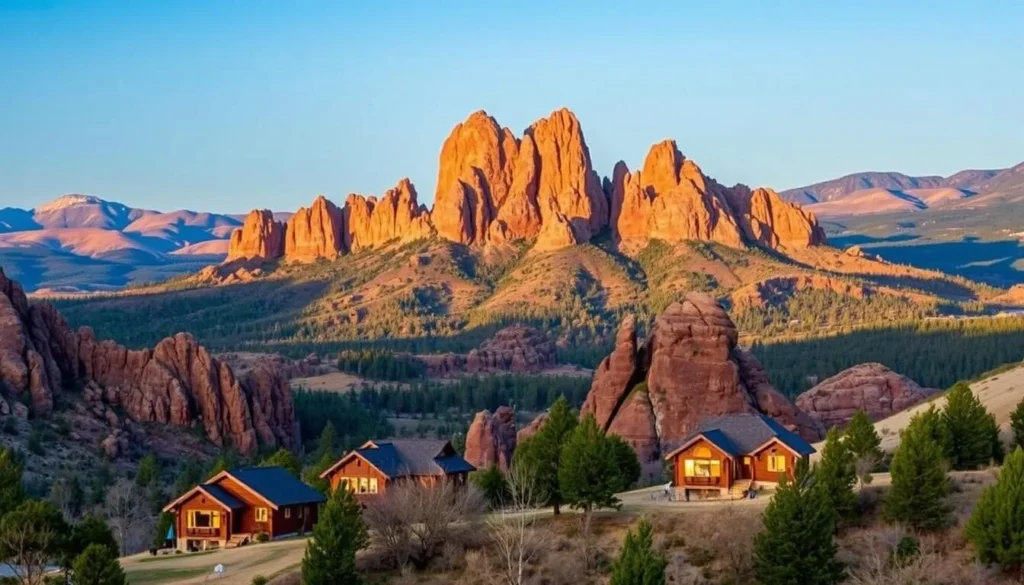
For budget-conscious travelers, Bunk + Brew Historic Lucas House is a great option, offering both private and shared rooms in a social atmosphere perfect for meeting fellow outdoor enthusiasts.
Seasonal Considerations for Your Visit
When planning your trip to Smith Rock State Park, timing is everything. The park offers a unique experience throughout the year, but certain seasons are more ideal than others for various activities.
Spring and Fall: The Ideal Seasons
Spring and Fall are considered the best times to visit Smith Rock State Park. During these seasons, the temperatures are pleasant, and the crowds are smaller compared to the peak summer months.
In the spring, from April to June, the park comes alive with blooming wildflowers, and the lush green vegetation following winter moisture creates a picturesque landscape. The comfortable daytime temperatures in the 60s-70s°F make it an ideal time for hiking and climbing.
- The spring season offers stable weather patterns, fewer crowds, and longer daylight hours, making it perfect for extended adventures on the hiking trails.
- In the fall, from September to October, the park is painted with vibrant autumn colors as the foliage changes, creating a stunning backdrop for your visit.
Both spring and fall provide optimal climbing conditions, with cooler rock temperatures making these seasons particularly popular among the climbing community.
| Season | Weather | Activities |
|---|---|---|
| Spring (April-June) | Mild temperatures, blooming wildflowers | Hiking, climbing, wildlife viewing |
| Fall (September-October) | Pleasant weather, autumn colors | Hiking, climbing, photography |
These shoulder seasons offer the perfect balance of comfortable temperatures, reasonable crowd levels, and beautiful natural conditions, making them ideal for your visit to Smith Rock State Park.
Seasonal Considerations for Your Visit
As you prepare to visit Smith Rock State Park, consider the distinct characteristics of summer and winter. Understanding these seasonal variations can significantly enhance your experience.
Summer Visits
Summer at Smith Rock State Park can be quite hot, especially during peak daytime hours. To make the most of your visit, plan your activities for the early mornings and late afternoons when temperatures are cooler.
- Summer temperatures frequently exceed 90-100°F during midday hours, making early morning or evening hikes essential for comfortable exploration.
- Despite the heat, summer offers the longest daylight hours for extended adventures and consistently dry conditions that make planning outdoor activities more predictable.
Winter Visits
Winter transforms Smith Rock State Park into a serene landscape. While the colder temperatures and potential icy trail conditions can present challenges, the unique beauty of the park during this season is undeniable.
- Winter visitors should come prepared with microspikes or traction devices for hiking trails, as icy conditions can make even moderate paths challenging and potentially hazardous.
- The dramatic reduction in visitor numbers during winter months provides a serene, almost private experience of the park’s natural beauty, though some climbing routes may be inaccessible due to ice and cold temperatures.
| Season | Weather Conditions | Trail Conditions | Visitor Experience |
|---|---|---|---|
| Summer | Hot, with temperatures often exceeding 90-100°F | Dry and accessible | Crowded, with extended daylight hours for exploration |
| Winter | Cold, with potential snow and ice | May be icy and challenging | Serene and peaceful, with unique landscapes |
By understanding the characteristics of each season, you can better plan your visit to Smith Rock State Park and enjoy the trails and activities that suit your preferences.
Conclusion: Making the Most of Your Smith Rock Adventure
Smith Rock State Park offers an unforgettable experience, combining stunning geology, varied ecosystems, and exciting outdoor activities. As you explore the park, you’ll discover a world of adventure that caters to all ability levels and interests.
Plan Your Visit according to the season to make the most of your trip. Spring and fall are ideal for comfortable hiking and climbing conditions, while summer requires early or late-day activities to avoid the heat. Winter visits offer solitude, but be sure to prepare accordingly.
Don’t miss the signature experiences that Smith Rock State Park has to offer. Hike the Misery Ridge Trail for panoramic views, explore the riverside trails for wildlife viewing, and watch the sunset transform the rock formations into a breathtaking canvas of colors.
The park’s diverse trail system allows you to customize your adventure based on your interests, fitness level, and available time. Whether you’re visiting for a day trip or an extended stay, Smith Rock State Park truly deserves its reputation as one of Oregon’s Seven Wonders—a place where dramatic geology, diverse ecosystems, and recreational opportunities combine to create an unforgettable natural destination.
As you conclude your visit, you’ll leave with memories of the park’s unique landscapes and the experiences you had while exploring Smith Rock State Park. With its world-class rock climbing, scenic hiking trails, and abundant wildlife, this park is a must-visit destination for any outdoor enthusiast.
